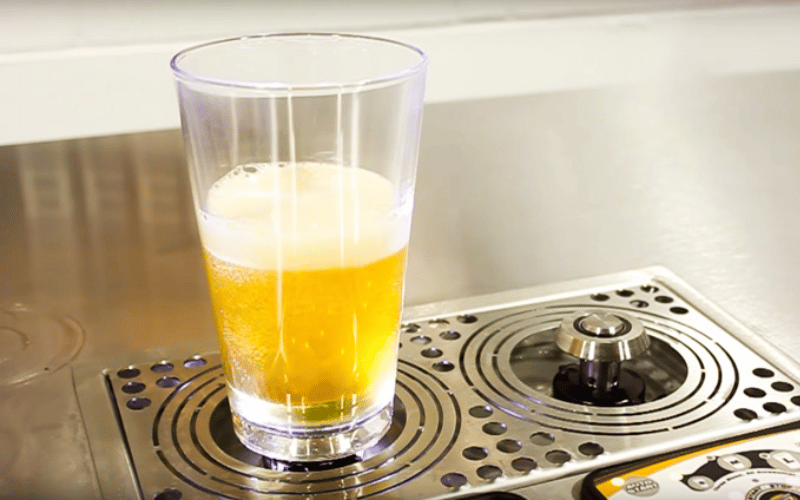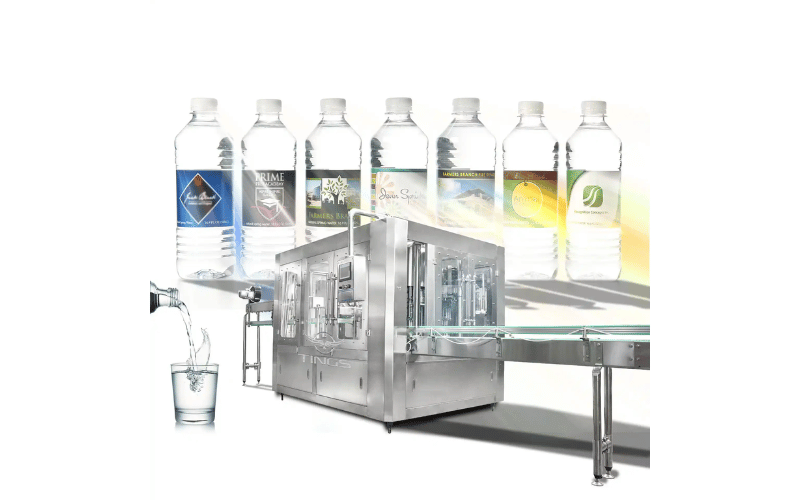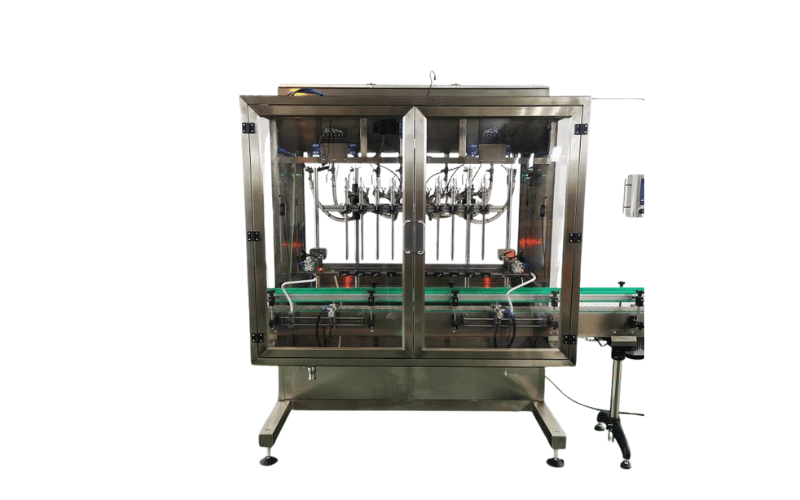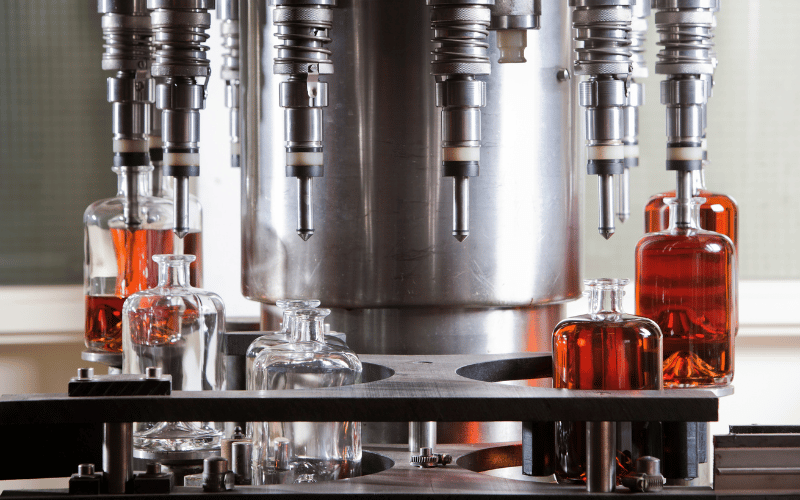Los sistemas de llenado inferior están revolucionando la forma de servir cerveza, ofreciendo una mezcla de innovación, eficiencia y entretenimiento. A diferencia de los métodos tradicionales de vertido por la parte superior, estos sistemas llenan los vasos por la parte inferior utilizando vasos especializados y válvulas magnéticas, lo que garantiza precisión, rapidez y un desperdicio mínimo. Los sistemas de llenado por la parte inferior, populares en lugares de gran volumen como estadios, festivales y bares muy concurridos, no sólo agilizan las operaciones, sino que también mejoran la experiencia del cliente con su diseño único y atractivo. Este artículo analiza la mecánica, las ventajas y las aplicaciones prácticas de estos dispensadores de cerveza de última generación, y explica por qué están cambiando las reglas del juego en el sector de las bebidas.
Tabla de contenido
ToggleSistemas de llenado de fondo para cerveza de barril
Los sistemas de llenado inferior de cerveza de barril son un enfoque innovador para servir cerveza, diseñado para mejorar la eficiencia, reducir los residuos y mejorar la experiencia general del cliente. A diferencia de los métodos tradicionales de vertido por la parte superior, estos sistemas llenan el vaso o la copa desde abajo, utilizando un mecanismo especializado que garantiza la precisión y la velocidad.
¿Qué es un dispensador de cerveza Bottoms Up?
Un dispensador de cerveza Bottoms Up es un dispositivo único que llena los vasos o copas de cerveza por la parte inferior en lugar de por la superior. Utiliza vasos especialmente diseñados con una pequeña válvula magnética en la base. Cuando se coloca en el dispensador, la válvula se abre, permitiendo el paso de la cerveza. Una vez lleno el vaso, la válvula se vuelve a cerrar, evitando derrames y manteniendo la frescura.
Este sistema es especialmente popular en entornos de gran volumen, como estadios, festivales y bares muy concurridos, donde la velocidad y la uniformidad son fundamentales.
Cómo funciona el relleno del fondo
El proceso de llenado del fondo se basa en una combinación de equipos especializados y gravedad. Así es como funciona:
- Copas especializadas: Los vasos tienen una pequeña abertura en el fondo, sellada con un disco magnético o una válvula.
- Mecanismo dispensador: El dispensador está equipado con una boquilla que se alinea con la abertura inferior del vaso.
- Proceso de llenado: Cuando se coloca el vaso en el dispensador, la válvula magnética se abre y la cerveza fluye desde la parte inferior. El flujo se controla para minimizar la espuma y garantizar un vertido uniforme.
- Caza de focas: Una vez retirada la taza, la válvula magnética se vuelve a cerrar, evitando fugas o derrames.
Este método no sólo acelera el proceso de servicio, sino que también garantiza un vertido homogéneo en todo momento.
Ventajas de los sistemas de llenado inferior de cerveza de barril
- Velocidad y eficiencia: Los sistemas de llenado inferior pueden llenar varios vasos simultáneamente, lo que reduce significativamente los tiempos de espera durante los periodos de mayor afluencia.
- Residuos reducidos: El vertido controlado minimiza la espuma y los derrames, lo que garantiza que acabe más cerveza en el vaso y se desperdicie menos.
- Consistencia: Todas las coladas son uniformes, lo que aumenta la satisfacción del cliente y reduce las reclamaciones.
- Higiene: Dado que la cerveza fluye directamente al vaso sin contacto con superficies externas, el sistema es más higiénico que los métodos tradicionales.
- Experiencia del cliente: La novedad de ver cómo se llena la cerveza desde el fondo añade un elemento de entretenimiento, convirtiéndolo en una experiencia memorable para los clientes.
Al combinar innovación y practicidad, los sistemas de llenado inferior de cerveza de barril están revolucionando la forma de servir cerveza en entornos de gran demanda.
Componentes de un sistema de cerveza de barril Bottoms Up
Los sistemas de cerveza de barril Bottoms Up están formados por varios componentes clave que trabajan juntos para ofrecer una experiencia de escanciado de cerveza perfecta y eficiente. Cada componente desempeña una función específica para garantizar la velocidad, la uniformidad y la calidad de cada servicio.
Piezas clave del dispensador de cerveza
El dispensador de cerveza es el corazón del sistema, diseñado para llenar vasos desde el fondo con precisión. Sus principales componentes son:
- Mecanismo de boquilla: Se alinea con el fondo del vaso y controla el flujo de cerveza. Asegura una espuma mínima y un vertido suave.
- Placa base: La zona donde se coloca la taza. Sujeta firmemente la taza durante el proceso de llenado.
- Sistema de control de caudal: Regula la velocidad y la cantidad de cerveza dispensada, evitando desbordamientos y desperdicios.
- Activador magnético de válvulas: Se acopla a la válvula magnética del vaso para abrir y cerrar la junta inferior durante el llenado.
Estas piezas trabajan en armonía para que el dispensador sea rápido, fiable y fácil de usar, incluso en entornos de alta demanda.
El papel del barril en el suministro de cerveza
El barril es el origen de la cerveza y desempeña un papel crucial en el mantenimiento de su calidad y frescura. Entre los aspectos clave del papel del barril se incluyen:
- Presurización: El barril se presuriza con CO2 o nitrógeno para empujar la cerveza a través del sistema. Esto garantiza un flujo constante y evita que la cerveza se desinfle.
- Control de temperatura: Los barriles se mantienen a una temperatura óptima para conservar el sabor y la carbonatación de la cerveza.
- Conexión al sistema: El barril se conecta al dispensador mediante mangueras y acopladores, lo que garantiza una transferencia de cerveza sin fisuras.
Si no se realiza un mantenimiento adecuado del barril, el rendimiento de todo el sistema puede verse comprometido, lo que puede provocar vertidos irregulares o cerveza sin gas.
Importancia de la tecnología magnética y de discos
La tecnología magnética y de discos es lo que diferencia a los sistemas Bottoms Up de los dispensadores de cerveza tradicionales. He aquí por qué es esencial:
- Válvula magnética: Cada taza tiene una válvula magnética en la parte inferior que se abre durante el llenado y se vuelve a cerrar después. Esto evita fugas y garantiza una experiencia limpia y sin derrames.
- Discos reutilizables: Los discos magnéticos son reutilizables y duraderos, lo que hace que el sistema sea rentable y respetuoso con el medio ambiente.
- Precisión e higiene: La tecnología garantiza que la cerveza fluya directamente al vaso sin contaminación externa, manteniendo la higiene y la calidad.
Este innovador uso de imanes y discos no sólo mejora la funcionalidad del sistema, sino que añade un elemento único y atractivo para los clientes.
Instalación y configuración
La instalación y configuración adecuadas de un sistema de cerveza de barril Bottoms Up son esenciales para garantizar un funcionamiento sin problemas y la máxima eficacia. Seguir los pasos adecuados y abordar los posibles problemas puede hacer que el proceso sea fluido y sin complicaciones.
Guía de instalación paso a paso
- Preparar el espacio: Identifique la ubicación del dispensador y asegúrese de que tiene acceso a la corriente eléctrica, una ventilación adecuada y una superficie estable.
- Instalar el dispensador: Fije el dispensador en la superficie designada, asegurándose de que esté nivelado para evitar derrames o vertidos desiguales.
- Conectar el barril: Conecte el barril al sistema utilizando los acopladores y mangueras adecuados. Asegúrese de que todas las conexiones estén bien apretadas para evitar fugas.
- Configuración del depósito de CO2 o nitrógeno: Conecte el depósito de gas al barril y ajuste la presión al nivel recomendado para el tipo de cerveza que se va a servir.
- Calibrar el sistema: Pruebe el caudal y ajuste la configuración del dosificador para minimizar la espuma y garantizar un vertido uniforme.
- Realizar un vertido de prueba: Utilice un vaso de prueba para comprobar el funcionamiento del sistema. Busque fugas, problemas de espuma o irregularidades en el vertido.
- Formar al personal: Proporcionar un tutorial rápido al personal sobre cómo utilizar el sistema, incluida la colocación correcta de las tazas y la resolución de problemas menores.
Desafíos comunes a la hora de instalar
- Ajuste incorrecto de la presión: Ajustar la presión de CO2 o nitrógeno demasiado alta o demasiado baja puede provocar un exceso de espuma o una cerveza plana.
- Conexiones sueltas: Las fugas suelen producirse por mangueras o acoplamientos mal fijados.
- Componentes incompatibles: El uso de un tipo incorrecto de acoplador de barril o de mangueras puede alterar el funcionamiento del sistema.
- Líneas obstruidas: Los conductos de cerveza que no se limpian antes de la instalación pueden causar obstrucciones y afectar a la calidad del vertido.
Afrontar estos retos durante la instalación puede ahorrar tiempo y evitar problemas operativos más adelante.
Consejos para una instalación óptima en bares y restaurantes
- Elija la ubicación adecuada: Coloque el dispensador en una zona muy transitada y de fácil acceso para el personal, pero que no obstruya el flujo de clientes.
- Mantener una temperatura adecuada: Asegúrese de que la zona de almacenamiento de barriles esté siempre fría para preservar la calidad de la cerveza.
- Limpieza periódica: Limpie regularmente los conductos de cerveza y los componentes del dispensador para evitar acumulaciones y mantener la higiene.
- Discos magnéticos adicionales en stock: Tenga a mano un suministro de discos magnéticos de repuesto para evitar interrupciones durante los periodos de mayor actividad.
- Optimizar la formación del personal: Formar al personal para que maneje el sistema con eficacia, incluida la resolución de problemas comunes como la espuma o las fugas.
Siguiendo estos consejos, los bares y restaurantes pueden maximizar los beneficios de su sistema de cerveza de barril Bottoms Up, garantizando una experiencia agradable y sin problemas tanto para el personal como para los clientes.
Técnicas de vertido y eficacia
Dominar las técnicas de vertido de un sistema de cerveza de barril Bottoms Up es esencial para maximizar la eficacia y garantizar un vertido perfecto en todo momento. Estos sistemas están diseñados para agilizar el proceso, pero un manejo adecuado puede marcar la diferencia.
Cómo servir cerveza desde el fondo
Servir cerveza con un sistema Bottoms Up es sencillo, pero requiere prestar atención a los detalles:
- Preparar la copa: Utilice el vaso especialmente diseñado con una válvula magnética en el fondo. Asegúrese de que el vaso esté limpio y libre de residuos.
- Alinear la copa: Coloque el vaso en la boquilla del dispensador, asegurándose de que la válvula inferior quede perfectamente alineada con la boquilla.
- Iniciar el vertido: Presione suavemente el vaso para activar la válvula magnética. La cerveza empezará a fluir hacia el interior del vaso desde el fondo.
- Supervisar el llenado: Vigile el nivel de cerveza a medida que sube. El sistema está diseñado para minimizar la espuma, pero puede ser necesario realizar ligeros ajustes en el caudal.
- Retirar la copa: Una vez que la cerveza alcance el nivel deseado, levante el vaso de la boquilla. La válvula magnética se volverá a cerrar automáticamente, evitando derrames.
Este método garantiza un vertido uniforme con un desperdicio mínimo, por lo que resulta ideal para grandes volúmenes.
Tiempo: Llenar un vaso en 7 segundos
Una de las características más destacadas de los sistemas Bottoms Up es su rapidez. Un vaso o taza estándar puede llenarse en tan sólo 7 segundos, gracias a su eficiente diseño. He aquí cómo conseguirlo:
- Optimizar los ajustes de presión: Asegúrese de que la presión de CO2 o nitrógeno está ajustada correctamente para mantener un flujo constante sin excesiva espuma.
- Utiliza la talla de copa adecuada: Las tazas más grandes pueden tardar un poco más en llenarse, así que ajuste las expectativas en función del tamaño.
- Prácticas: El personal debe practicar la colocación y retirada rápida de las tazas para minimizar el tiempo de inactividad entre servicios.
Al mantener un tiempo de vertido constante de 7 segundos, los bares y restaurantes pueden servir a más clientes en menos tiempo, lo que aumenta la eficacia general.
Soluciones de vertido manos libres
Para una eficiencia aún mayor, algunos sistemas Bottoms Up ofrecen opciones de vertido manos libres. Estas soluciones son perfectas para entornos ajetreados en los que la velocidad y la multitarea son esenciales:
- Distribuidores automáticos: Estos sistemas permiten al personal colocar varios vasos a la vez en el dispensador. La máquina llena cada vaso automáticamente, liberando al personal para que pueda ocuparse de otras tareas.
- Niveles de relleno preestablecidos: Algunos dispensadores pueden programarse para que dejen de verter una vez que el vaso alcanza un nivel específico, lo que garantiza la coherencia sin necesidad de control manual.
- Portavasos y guías: Accesorios como los portavasos o las guías de alineación facilitan la correcta colocación de los vasos, reduciendo los errores y agilizando el proceso.
Las soluciones manos libres no sólo mejoran la eficacia, sino que también reducen el riesgo de derrames o desbordamientos, lo que las convierte en un valioso complemento para cualquier operación de gran volumen.
Cómo elegir el sistema de cerveza de barril Bottoms Up adecuado
La selección del sistema de cerveza de barril Bottoms Up ideal para su local requiere una cuidadosa consideración de varios factores. La elección correcta puede aumentar la eficiencia, reducir los residuos y mejorar la satisfacción del cliente.
Factores a tener en cuenta para los lugares de celebración
- Volumen de servicio: Evalúe el número de clientes que atiende diariamente. Los lugares de gran volumen, como estadios o festivales, pueden necesitar sistemas con varios dispensadores para gestionar la demanda de forma eficiente.
- Disponibilidad de espacio: Asegúrese de que el sistema encaja en su bar o zona de servicio sin interrumpir el flujo de trabajo. Los modelos compactos son ideales para espacios reducidos.
- Tipo de bebidas: Tenga en cuenta la variedad de cervezas que sirve. Algunos sistemas son más adecuados para tipos específicos, como las lagers o las stouts, debido a sus niveles de carbonatación.
- Facilidad de uso: Busque sistemas intuitivos y fáciles de manejar para el personal, sobre todo en horas punta.
- Requisitos de mantenimiento: Elija un sistema con procesos de limpieza y mantenimiento sencillos para minimizar el tiempo de inactividad.
Evaluando estos factores, podrá seleccionar un sistema que se ajuste a las necesidades específicas de su local.
Comparación de diferentes modelos de dispensadores de cerveza
Cuando compare los dispensadores de cerveza Bottoms Up, céntrese en los siguientes aspectos:
- Número de surtidores: Algunos modelos ofrecen dispensadores individuales, mientras que otros pueden llenar varios vasos simultáneamente. Los modelos de gran capacidad son ideales para locales muy concurridos.
- Funciones de automatización: Los modelos avanzados incluyen vertido manos libres y niveles de llenado preestablecidos, que mejoran la eficacia y la uniformidad.
- Durabilidad: Busque sistemas fabricados con materiales de alta calidad que puedan soportar un uso intensivo en entornos ajetreados.
- Opciones de personalización: Algunos dispensadores permiten marcar o personalizar, añadiendo un toque único a su servicio.
Comparar estas características le ayudará a identificar el modelo que ofrece el mejor equilibrio entre funcionalidad y valor.
Coste vs. Beneficios de la actualización a sistemas de llenado de fondo
Actualizarse a un sistema de cerveza de barril Bottoms Up supone una inversión inicial, pero los beneficios a largo plazo suelen compensar los costes. He aquí por qué:
- Residuos reducidos: El preciso mecanismo de vertido minimiza la espuma y los derrames, ahorrando dinero en cerveza desperdiciada.
- Mayor velocidad: Los tiempos de entrega más rápidos le permiten atender a más clientes, lo que aumenta los ingresos durante los periodos de mayor afluencia.
- Mejora de la experiencia del cliente: La novedad de los sistemas de llenado de fondo crea una experiencia memorable que fomenta la repetición.
- Menores costes laborales: Las funciones de manos libres y automatizadas reducen la carga de trabajo del personal, lo que le permite centrarse en otras tareas.
Aunque el coste inicial puede parecer importante, la eficacia, el ahorro y la mejora de la satisfacción del cliente hacen que la inversión merezca la pena para la mayoría de los locales.
Preguntas frecuentes
P: ¿Qué es un dispensador de cerveza de llenado inferior?
R: Un dispensador de cerveza de llenado inferior es un sistema innovador que llena la cerveza desde el fondo del vaso. Este diseño reduce el desbordamiento de espuma y acelera el proceso de vertido. Utiliza una boquilla que se conecta a un orificio en el fondo de un vaso o taza especialmente diseñado, que puede personalizarse para diferentes locales.
P: ¿Cómo funciona el sistema de cerveza de barril Bottoms Up?
R: El sistema de cerveza de barril Bottoms Up utiliza un sello magnético en la parte inferior del vaso. Cuando el vaso se coloca en el dispensador, el sello se abre, permitiendo que la cerveza fluya desde el fondo. Esto garantiza un vertido perfecto con un mínimo de espuma. El sistema puede llenar hasta 56 pintas por minuto, lo que lo hace ideal para locales de gran demanda como estadios y centros de ocio.
P: ¿Qué ventajas tiene utilizar un dispensador de cerveza que se llena por la parte inferior?
R: Un dispensador de cerveza de llenado inferior ofrece varias ventajas, como la reducción de espuma, un servicio más rápido y la posibilidad de servir a más clientes en menos tiempo. Estas ventajas pueden aumentar la rentabilidad de los propietarios de bares y restaurantes, especialmente durante los periodos de mayor afluencia.
P: ¿Se puede utilizar el dispensador de cerveza Bottoms Up con vasos de plástico?
R: Sí, el dispensador de cerveza Bottoms Up funciona tanto con vasos de plástico desechables como con cristalería reutilizable. Esta flexibilidad permite a los locales adaptar su servicio a diferentes eventos, ya sean informales o de lujo.
P: ¿Quién es Josh Springer y qué relación tiene con los sistemas dispensadores de cerveza?
R: Josh Springer es el inventor del sistema dispensador de cerveza de barril Bottoms Up. Su innovador diseño ha transformado la industria cervecera al ofrecer una forma más rápida y eficiente de servir cerveza de barril, lo que supone un rápido retorno de la inversión para las empresas.
P: ¿Qué tipos de locales pueden beneficiarse de un sistema dispensador de cerveza que se llena por la parte inferior?
R: Bares, restaurantes, instalaciones deportivas y centros de ocio pueden beneficiarse de un sistema dispensador de cerveza de llenado inferior. Estos sistemas son especialmente útiles en zonas de gran afluencia, donde la rapidez y la eficacia son esenciales para la satisfacción del cliente.
P: ¿Cómo mejora el flujo de trabajo del camarero el uso de un grifo de cerveza de llenado inferior?
R: Un grifo de cerveza de llenado inferior agiliza el flujo de trabajo del camarero al permitir el funcionamiento manos libres. Esto reduce el tiempo dedicado a servir y elimina la necesidad de realizar ajustes manuales, lo que permite a los camareros servir a más clientes de forma rápida y eficiente.
P: ¿Qué importancia tiene un cierre magnético en un vaso de cerveza que se llena hasta el fondo?
R: El cierre magnético de un vaso de cerveza de llenado inferior evita los derrames y garantiza un vertido limpio y preciso. Cuando se coloca el vaso en el dispensador, el precinto se abre para dejar pasar la cerveza. Una vez retirado, el precinto se cierra para mantener la bebida contenida, mejorando la funcionalidad y fiabilidad del sistema.
Resumen final:
Los sistemas de llenado inferior de cerveza de barril combinan tecnología avanzada con ventajas prácticas, lo que los convierte en la opción ideal para entornos de gran demanda. Desde su velocidad y eficiencia hasta su capacidad para reducir los residuos y mejorar la higiene, estos sistemas abordan los principales retos de los métodos tradicionales de suministro de cerveza. Gracias a la tecnología de válvula magnética y a las soluciones manos libres, garantizan un servicio uniforme y mejoran la experiencia del cliente. Tanto si gestiona un bar bullicioso como un estadio abarrotado, la inversión en un sistema de llenado de fondo puede transformar sus operaciones, aumentar la satisfacción del cliente y ofrecer valor a largo plazo.
Publicaciones relacionadas
- Línea completa de producción de agua embotellada: soluciones eficientes para la producción de agua
- Máquina llenadora automática de botellas de alta calidad: las mejores soluciones para las necesidades de llenado de botellas
- Acerca de
- Comprensión del sistema de limpieza CIP: una guía esencial para las técnicas de limpieza in situ





